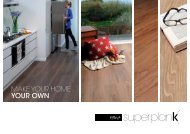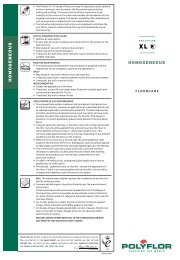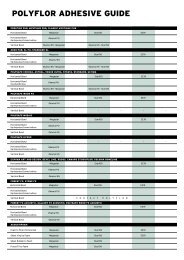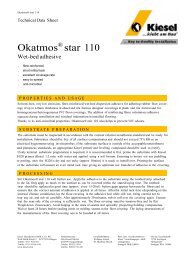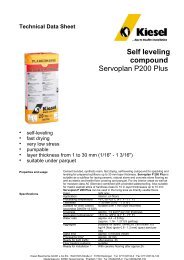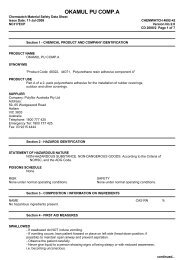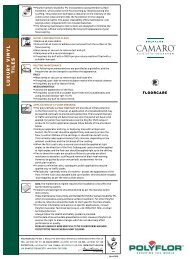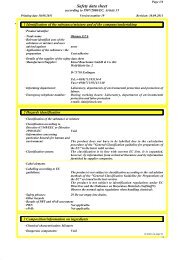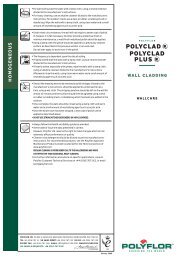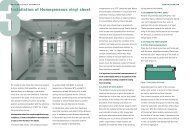Safety Solutions Brochure - Polyflor
Safety Solutions Brochure - Polyflor
Safety Solutions Brochure - Polyflor
You also want an ePaper? Increase the reach of your titles
YUMPU automatically turns print PDFs into web optimized ePapers that Google loves.
28<br />
TYPE OF CHEMICAL<br />
Aqueous <strong>Solutions</strong><br />
EFFECT ACTION<br />
Mild acids and alkalis No effect<br />
Strong alkalis May cause discolouration<br />
in some shades<br />
Dilute and remove<br />
Strong acids Prolonged contact can Dilute and remove<br />
cause discolouration immediately<br />
Dyes (indicators) Contact can cause Dilute and remove<br />
Organic Liquids<br />
discolouration immediately<br />
Aldehydes Flooring attack occurs Wipe up<br />
Esters<br />
Halogenated<br />
hydrocarbons<br />
Ketones<br />
after several minutes immediately<br />
Alcohols After several days, Wipe up<br />
Ethers plasticiser extraction immediately<br />
Glycols occurs, with associated<br />
Hydrocarbons problems of shrinkage<br />
(aromatic and aliphatic)<br />
Petroleum spirit<br />
Vegetable oil<br />
and embrittlement<br />
For the more serious potential spillages on safety<br />
flooring such as petrol and strong acids, these are not<br />
harmful, provided any spillage is cleaned off immediately.<br />
The table above gives a very general guide, but best<br />
practice in this area is to ask <strong>Polyflor</strong> Customer<br />
Technical Services for advice on your specific project<br />
and the likely contaminants in the area.<br />
LIGHT REFLECTANCE VALUES<br />
All shades in the Polysafe portfolio have<br />
appropriate light reflectance values, available directly<br />
from <strong>Polyflor</strong>. In line with Part M of the Building<br />
Regulations for new buildings and allied to the<br />
Disability Discrimination Act 1995, there should be a<br />
visual contrast between the floor and wall, in terms of<br />
a measurable difference in light reflectance values<br />
recorded for floor and wall surfaces. Contact the<br />
Customer Technical Support Team for more<br />
information.<br />
ANTIMICROBIAL PERFORMANCE<br />
All Polysafe ranges contain antimicrobial<br />
agents. This is especially important given that<br />
safety flooring is often installed in wet areas<br />
that are both warm and trafficked by bare feet.<br />
In the healthcare environment, where the issue of<br />
hygiene continues to make headlines in an age of<br />
MRSA and Hospital acquired infections, all Polysafe<br />
products have been independently tested and results<br />
demonstrate that all ranges inhibit the growth of<br />
MRSA on the flooring. A key issue following on from<br />
this is that an effective cleaning regime is the most<br />
important defence against infection and the floor<br />
inhibiting infection alone should not take the place of<br />
regular maintenance.<br />
It is always prudent to obtain maintenance instructions<br />
for the specified floorcovering from your chosen<br />
flooring manufacturer. Complete cleaning and<br />
maintenance instructions can be found for each<br />
Polysafe range on specific floorcare sheets, available<br />
to download online or directly from <strong>Polyflor</strong>.<br />
LOW VOLATILE ORGANIC COMPOUNDS (VOCS)<br />
In order to contribute to a healthier<br />
environment with the reduction of emissions into the<br />
atmosphere, Polysafe ranges have<br />
independent certification classifying them as<br />
Low VOC products. Tested to the AgBB test<br />
(Chamber test), the various VOC emissions are<br />
weighted according to the level of toxicity. The total<br />
VOCs emitted from Polysafe flooring falls well within<br />
set VOC limits, receiving results below the limit<br />
permitted.



